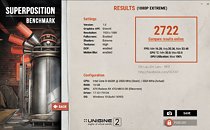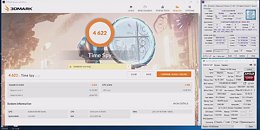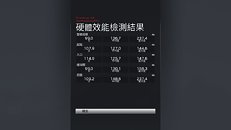Raevenlord
News Editor
- Joined
- Aug 12, 2016
- Messages
- 3,755 (1.23/day)
- Location
- Portugal
| System Name | The Ryzening |
|---|---|
| Processor | AMD Ryzen 9 5900X |
| Motherboard | MSI X570 MAG TOMAHAWK |
| Cooling | Lian Li Galahad 360mm AIO |
| Memory | 32 GB G.Skill Trident Z F4-3733 (4x 8 GB) |
| Video Card(s) | Gigabyte RTX 3070 Ti |
| Storage | Boot: Transcend MTE220S 2TB, Kintson A2000 1TB, Seagate Firewolf Pro 14 TB |
| Display(s) | Acer Nitro VG270UP (1440p 144 Hz IPS) |
| Case | Lian Li O11DX Dynamic White |
| Audio Device(s) | iFi Audio Zen DAC |
| Power Supply | Seasonic Focus+ 750 W |
| Mouse | Cooler Master Masterkeys Lite L |
| Keyboard | Cooler Master Masterkeys Lite L |
| Software | Windows 10 x64 |
Some photos, screenshots and benchmarks of what appears to be an XFX RX 580 graphics card are doing the rounds, courtesy of overclocker Lau Kin Lam, who shared them (alongside a three-hour log video) on his Facebook page. Apparently, this is a special, China-only edition of the card, which is a shame, considering the great-looking waterblock that is smiling for the camera. The fact that this card is using a reference board with one 8-pin power connector may prove relevant to its overclocking efforts (and those of other, non-reference boards that we've seen carry both the 8-pin and an extra 6-pin power connector.







As to the results, these are completely as expected of a Polaris chip clocked at both the stock RX 580 clocks (1360 MHz) and overclocked to a respectable 1480 MHz. There is apparently a power bug that brings overclocking efforts past the 1500 MHz+ barrier straight against a figurative wall, hindering extra performance gains - this is expected to be resolved soon rather than later. Lau Kin Lam reflected this on his comment, alluding to the fact that the 1480 MHz (120 MHz+) overclock was achieved with a measly 12 mV increase to stock voltage, while a hefty 100 mV increase was required to sustain 1500 MHz clocks - and unreliably at that. Actual 3D Mark TimeSpy score increase from overclocking (1360 MHz to 1480 MHz, 8% increase) was around 6%.

Actual average FPS on Tom Clancy's The Division on very High settings @ 1080p stand at 61.8 FPS, with Rainbow Six averaging 136.7 FPS on the same settings.


View at TechPowerUp Main Site







As to the results, these are completely as expected of a Polaris chip clocked at both the stock RX 580 clocks (1360 MHz) and overclocked to a respectable 1480 MHz. There is apparently a power bug that brings overclocking efforts past the 1500 MHz+ barrier straight against a figurative wall, hindering extra performance gains - this is expected to be resolved soon rather than later. Lau Kin Lam reflected this on his comment, alluding to the fact that the 1480 MHz (120 MHz+) overclock was achieved with a measly 12 mV increase to stock voltage, while a hefty 100 mV increase was required to sustain 1500 MHz clocks - and unreliably at that. Actual 3D Mark TimeSpy score increase from overclocking (1360 MHz to 1480 MHz, 8% increase) was around 6%.

Actual average FPS on Tom Clancy's The Division on very High settings @ 1080p stand at 61.8 FPS, with Rainbow Six averaging 136.7 FPS on the same settings.


View at TechPowerUp Main Site





